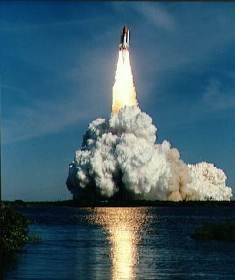MIT 8.01 Lesson 13: Momentum
Definition and Law of Change
Although Newton is famous for the law F = ma, he actually stated his Second Law in terms of momentum and its change due to impressed forces or impulses (the time integral of the force). He defined Momentum as
The quantity of motion is the measure of the same, arising from the velocity and quantity of matter conjointly. - DEFINITION II, Principia (Motte and Cajori).
In modern terminology, this definion becomes:

Newton's Second Law can be written in terms of momentum, and represents the fundamental law of change for the Momentum and External Force model:

This form is totally equivalent to F = ma, provided that the system under consideration has constant mass. Unlike the traditional F = ma formulation, however, the formulation of Newton's Second Law in terms of momentum is accurate even for systems whose mass is variable.
Newton emphasizes the linearity of momentum with both mass and velocity. He specifies our sum over different bodies by further stating that the motion of the whole is the sum of the motions of all the parts; and therefore in a body double in quantity, with equal velocity, the momentum is double; with twice the velocity also, it is quadruple.
Newton's Second Law is the fundamental law of change for momentum,
Frac
=\Sigma_j\vec
Where the sum goes over all the forces acting on any body in the system.
The mathematical relationship between force and momentum, or, for systems with constant mass, the relationship between force and acceleration.
Motivation for Concept
When you push, kick or use some other means to apply force to an object, its velocity will change. It is of value to be able to quantitatively define the strength of such a push, kick or other force by examining the effects of the force on the object which is the target. Such a quantitative understanding of force is the basis of the science of dynamics.
Statement of the Law
Newton's Statement
"A change in motion is proportional to the motive force impressed and takes place along the straight line in which that force is impressed." (The Principia by I. Newton, translated by I.B. Cohen and A. Whitman.)
Modern Statement
The modern form of the Law which is perhaps most consistent with Newton's statement is the integral formulation:

It is more common to express the Law in a differential form:

and, since it is rare to consider a system with changing mass, this form is often reduced to:

Use of the Law in Problem Solving
Form of the Second Law for Multiple Impressed Forces
When more than one force is impressed, the change in momentum is proportional to the vector sum of the forces. Thus, Newton's 2nd Law is usually expanded to state:

"Writing" Newton's Second Law
When a physics teacher or student says they are "writing Newton's 2nd Law" for a system, the form used should be that of the previous subsection, but expressed as several equations separated by vector component:

Directions that clearly have no forces acting are sometimes ignored.
Free Body Diagrams
Free body diagrams are pictorial guides to the specific form of Newton's 2nd Law for a given system. Drawing an accurate free body diagram shows visually what forces should be included in the statement of the law, and also gives information about the sign of the vector components of these forces.
Technically, the concept of linear momentum applies only to collections of point objects. The momentum of a rigid body is simply the sum of the momentum of each of the atoms in the body, which turns out to be the body's mass times its center of mass velocity. The momentum of a system composed of many rigid bodies and point particles is then the sum of their individual momenta, which again can be expressed as the total mass of this system times the velocity of the system's center of mass. This is true, and a valuable concept, especially when the system is composed of disparate objects going in different directions - for example a system of two cars about to have a collision, or after they have just had a collision.
Introduction to the ModelDescription and Assumptions
Learning ObjectivesStudents will be assumed to understand this model who can:
Relevant Definitions
S.I.M. Structure of the ModelCompatible SystemsThe system must be effectively composed of point particles, though rigid bodies may be treated as point particles with positions specified by the center of mass positions of the rigid body when this model is used. Relevant InteractionsOnly external forces need be considered, since internal forces do not change the system's momentum. Laws of ChangeMathematical RepresentationDifferential Form Integral Form Diagrammatic RepresentationsRelevant ExamplesExamples Involving Constant MomentumExamples Involving ImpulseExamples Involving 1-D CollisionsExamples Involving 2-D CollisionsExamples Involving Elastic CollisionsExamples Involving Totally Inelastic CollisionsExamples Involving Continuous Momentum FluxAll Examples Using this Model |
|
<script type="text/javascript">
var gaJsHost = (("https:" == document.location.protocol) ? "https://ssl." : "http://www.");
document.write(unescape("%3Cscript src='" + gaJsHost + "google-analytics.com/ga.js' type='text/javascript'%3E%3C/script%3E"));
</script>
<script type="text/javascript">
try {
var pageTracker = _gat._getTracker("UA-11762009-2");
pageTracker._trackPageview();
} catch(err) {}</script>



